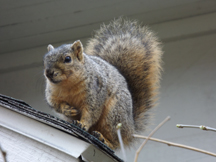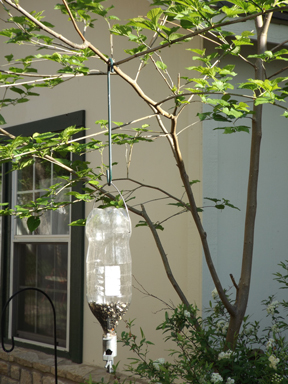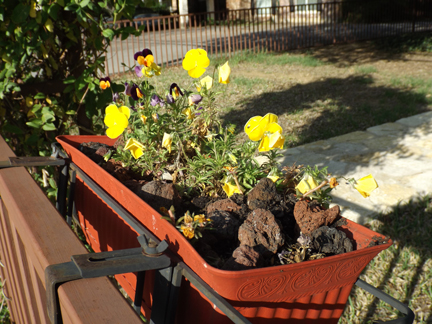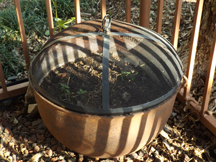by Shirley D. Smith, Somervell County Master Gardener
If you attended April’s Community Horticulture Education Series presented by the Somervell County Master Gardeners, then you know that the Monarch butterfly is headed our direction.
 When you travel and it begins to be lunchtime and your tummy tells you it needs food, you probably start to look for a good place to eat. Well . . . . . the Monarchs will be doing the same. They will have flown from north central Mexico and are hungry! They are also looking for a plant on which to lay their eggs. The plant they will be looking for is called Asclepias asperula or antelope horn. This plant grows right here in central Texas along with its cousins – other milkweeds. If you see a somewhat strange looking plant such as shown in the accompanying picture, then you are probably looking at antelope horn. It seems to be in abundance this year (at least it is on my property south of Glen Rose).
When you travel and it begins to be lunchtime and your tummy tells you it needs food, you probably start to look for a good place to eat. Well . . . . . the Monarchs will be doing the same. They will have flown from north central Mexico and are hungry! They are also looking for a plant on which to lay their eggs. The plant they will be looking for is called Asclepias asperula or antelope horn. This plant grows right here in central Texas along with its cousins – other milkweeds. If you see a somewhat strange looking plant such as shown in the accompanying picture, then you are probably looking at antelope horn. It seems to be in abundance this year (at least it is on my property south of Glen Rose).
 Antelope horn milkweed is an erect-stemmed plant growing to about 15 inches tall. Leaves are narrow, lance-shaped and about 3 inches long. The flowers are greenish with distinctive purplish horns and are present from March to October. The fruit is a wrinkled pod containing silk-tufted seeds.
Antelope horn milkweed is an erect-stemmed plant growing to about 15 inches tall. Leaves are narrow, lance-shaped and about 3 inches long. The flowers are greenish with distinctive purplish horns and are present from March to October. The fruit is a wrinkled pod containing silk-tufted seeds.
Every spring, millions of Monarch butterflies migrate north from the forested uplands of central Mexico’s Sierra Madre Occidental range. Some reach as far north as Canada. However, those making the journey in 2014 will be fewer in number than ever before. To further elaborate on their plight, here is an except from USA Today dated April 27, 2014:
Monarch butterflies once were so common that some people find it hard to believe that they are declining so rapidly.
“If you tell an old-timer that, they say, ‘Well, that can’t be, because when I was a kid they were everywhere,’ “
That was the case when Taylor, who grew up in Minnesota, was a child. He would put a caterpillar in a peanut-butter jar with a leaf and watch as it became a butterfly. It was a common experiment for kids who grew up in the Midwest and had an interest in nature.
The key to the butterfly experiment was simple: The leaf had to be a milkweed leaf. That’s all the caterpillar needed to survive to adulthood. Monarchs lay their eggs on milkweed and nothing else.
 Researchers believe the loss of milkweed plants is a big reason for the Monarchs’ decline.
Researchers believe the loss of milkweed plants is a big reason for the Monarchs’ decline.
Milkweed is not a cash crop and so has been eliminated from many Midwestern farm fields to make room for more corn and soybeans. Nabhan and others believe that simply planting milkweed in the path of the migration can increase the Monarchs’ numbers.
“We have to get the message out,” she said.
Because this butterfly has recently been found to be in dangerous decline, their plight has attracted political attention. Here is another except from that same article:
During their summit meeting in Toluca, Mexico, in February, the leaders of Mexico, the United States and Canada pledged to support the Monarch. Mexican President Enrique Peña Nieto, President Barack Obama and Canadian Prime Minister Stephen Harper called it a “landmark species” and said they hope to form a task force to address the problem.
If you are over 50, then you remember how abundant the Texas horned lizard or horny toad was when you were a kid. Up on the High Plains where I grew up, they were everywhere and we took their numbers for granted. When was the last time you saw one of these little guys? Yeah, me, too – not for years! Hopefully, the Monarch will make a come back and not become threatened as is our beloved Texas Horned Lizard.
The reason for this article is to make you aware that we could possibly lose this beautiful creature as we have almost lost the horny toad. What a terrible thought! You can do your part by making sure the milkweed growing in your yard, in your pasture, in your flowerbed or wherever is not destroyed!











 One herb certainly used by many of the early healers is Feverfew (Tanacetum parthenium) which tolerates many soil-types, is a perennial, and easy to grow. A patient would be required to chew the leaves of the Feverfew plant to alleviate fever, headache, cramps and arthritis. Old-timers planted it around their houses to “purify the atmosphere and ward off disease”.
One herb certainly used by many of the early healers is Feverfew (Tanacetum parthenium) which tolerates many soil-types, is a perennial, and easy to grow. A patient would be required to chew the leaves of the Feverfew plant to alleviate fever, headache, cramps and arthritis. Old-timers planted it around their houses to “purify the atmosphere and ward off disease”. Lemon Balm (Melissa officinallis) is one of my personal favorites because of its aroma. I was given a pot of it when I lived near Little Rock, Arkansas, and put it on my patio. It was prolific and spewed seeds as far as six feet out into the yard. Every time I mowed the grass I was rewarded with the heavenly scent of Lemon Balm.
Lemon Balm (Melissa officinallis) is one of my personal favorites because of its aroma. I was given a pot of it when I lived near Little Rock, Arkansas, and put it on my patio. It was prolific and spewed seeds as far as six feet out into the yard. Every time I mowed the grass I was rewarded with the heavenly scent of Lemon Balm. Mullein (Verbascum thapsus) is a biennial and considered a naturalized weed in the eastern states. In the Middle Ages the plants were called hag tapers because the stalks could be dipped in melted fat and lighted as a torch. They were thought to either be used by witches or used to drive them away.
Mullein (Verbascum thapsus) is a biennial and considered a naturalized weed in the eastern states. In the Middle Ages the plants were called hag tapers because the stalks could be dipped in melted fat and lighted as a torch. They were thought to either be used by witches or used to drive them away. Echinacea (Echinacea purpurea) was also a staple in the healer’s arsenal against disease/sickness and if it wasn’t needed, made a beautiful addition to the flower garden. Its one-inch purple petals are strikingly attractive. Echinacea can chase off or help speed recovery from an acute bacterial or viral infection—especially in the respiratory tract. It is available in capsule form in today’s health food stores.
Echinacea (Echinacea purpurea) was also a staple in the healer’s arsenal against disease/sickness and if it wasn’t needed, made a beautiful addition to the flower garden. Its one-inch purple petals are strikingly attractive. Echinacea can chase off or help speed recovery from an acute bacterial or viral infection—especially in the respiratory tract. It is available in capsule form in today’s health food stores.